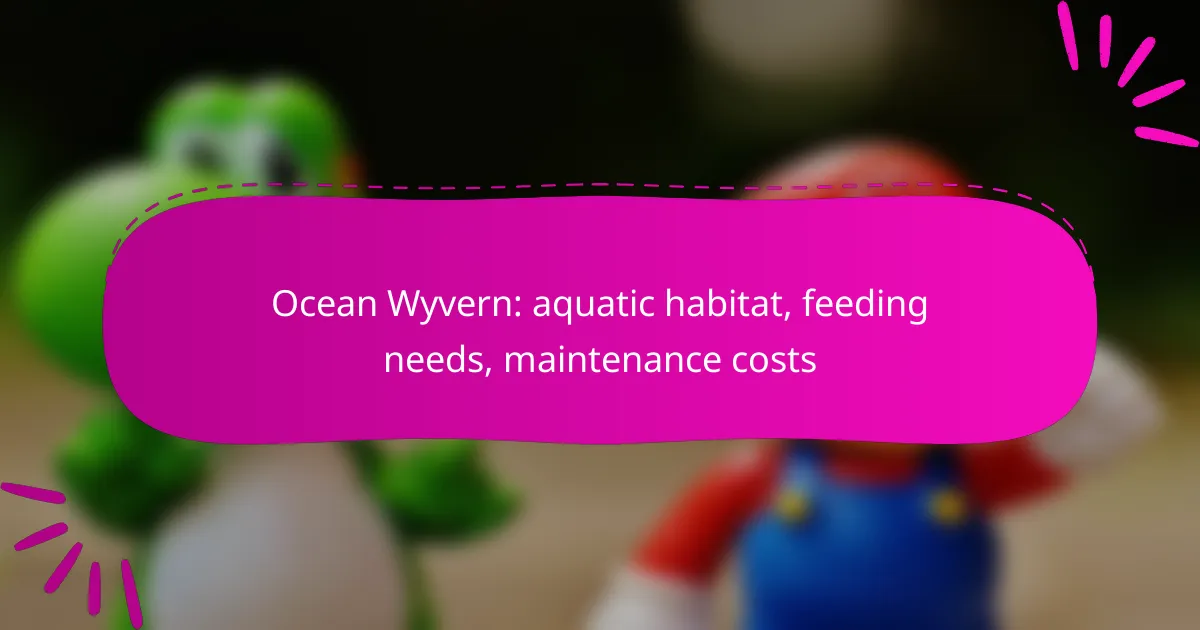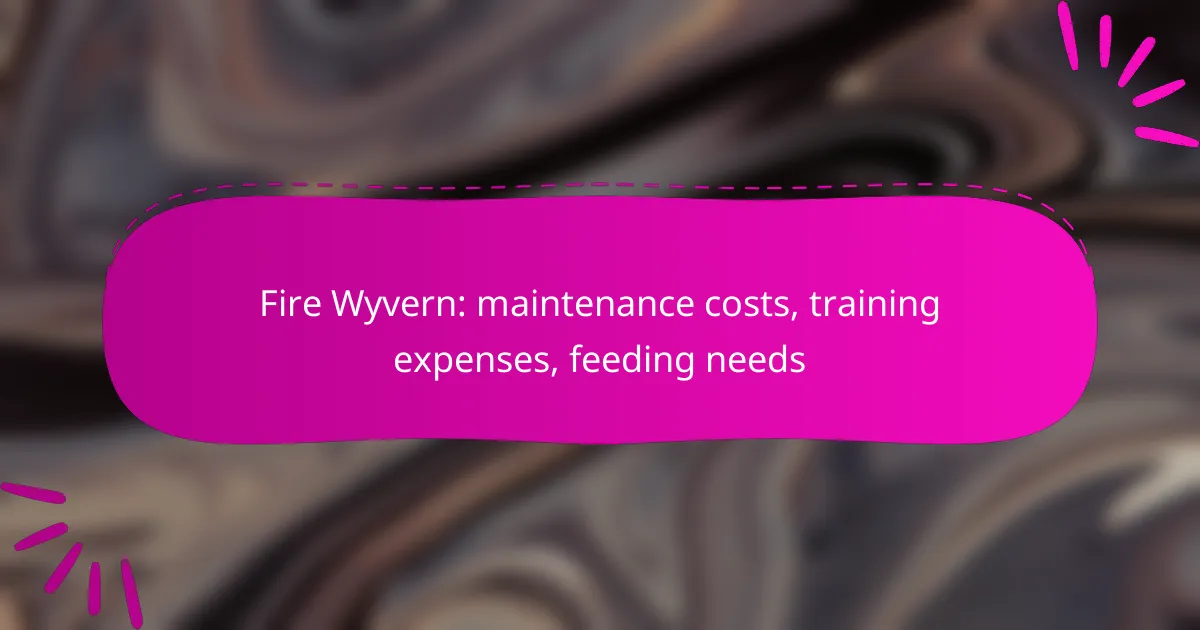Ember Wyverns require specialized care and habitat considerations to thrive, particularly in terms of fireproofing their living environments. Feeding costs can fluctuate based on their dietary preferences and local food availability, making budgeting essential for their upkeep. Additionally, effective care logistics are crucial, involving daily routines and emergency protocols tailored to their unique needs.
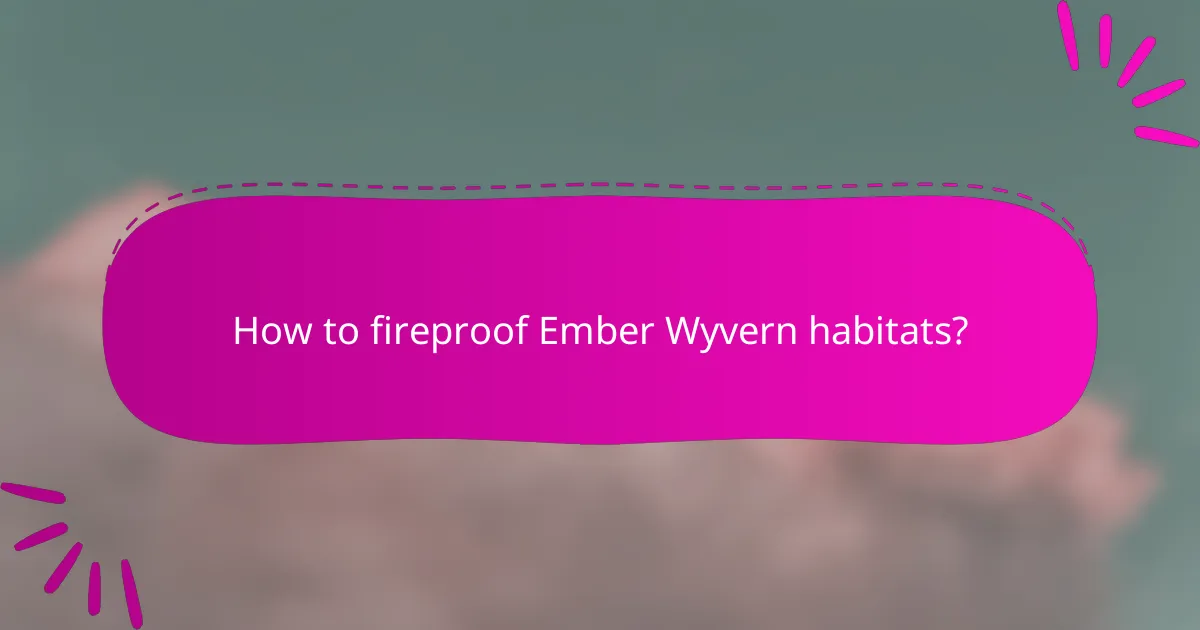
How to fireproof Ember Wyvern habitats?
To fireproof Ember Wyvern habitats, it’s essential to use materials and techniques that can withstand high temperatures. This ensures the safety of the wyverns and minimizes the risk of habitat destruction due to fire hazards.
Use fire-resistant materials
Selecting fire-resistant materials is crucial for constructing Ember Wyvern habitats. Options like concrete, steel, and specialized fire-retardant woods can significantly reduce fire risks. Avoid using untreated wood or flammable plastics, as these can ignite easily and compromise the habitat.
Incorporating fire-resistant insulation can also help maintain a safe environment. Look for insulation rated for high temperatures to ensure durability and effectiveness.
Implement heat shields
Heat shields are effective barriers that protect habitats from extreme temperatures. Installing heat shields made from reflective materials can deflect heat away from critical areas, reducing the risk of ignition. Consider placing these shields around the perimeter of the habitat and near any heat-generating equipment.
Regular maintenance of heat shields is necessary to ensure they remain effective. Inspect for wear and tear, and replace any damaged sections promptly to maintain optimal protection.
Regularly inspect for vulnerabilities
Conducting regular inspections of Ember Wyvern habitats is vital for identifying potential fire hazards. Check for cracks, gaps, or any signs of wear in fire-resistant materials and heat shields. Addressing these vulnerabilities early can prevent larger issues down the line.
Establish a routine inspection schedule, ideally every few months, to ensure all safety measures are intact. Document findings and repairs to maintain a comprehensive safety record for the habitat.
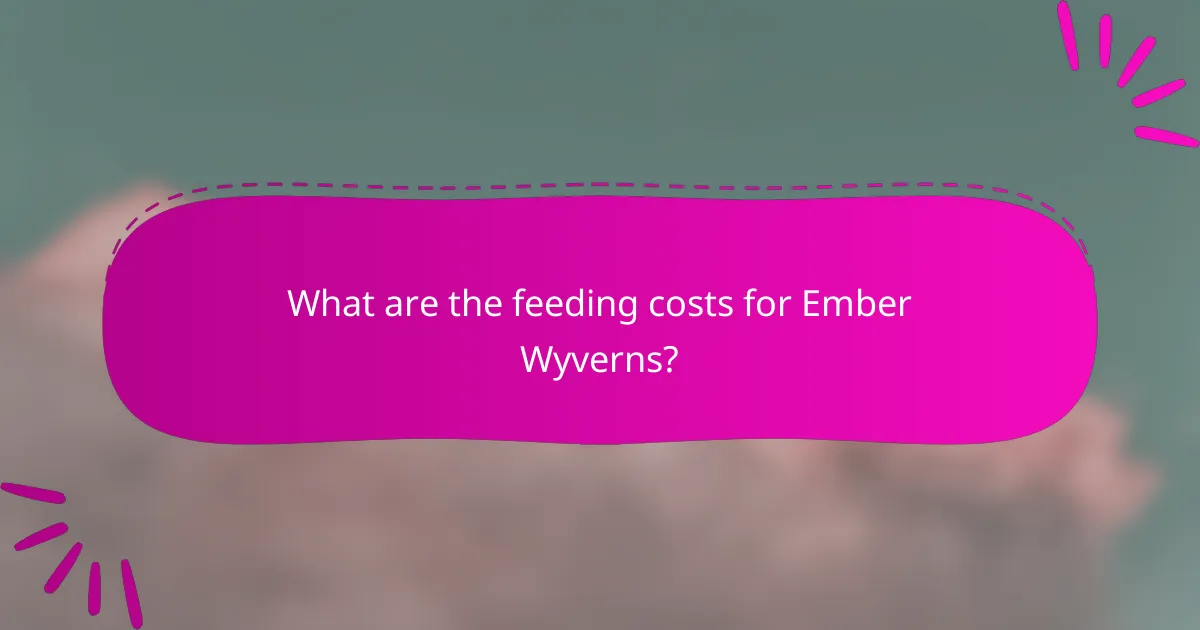
What are the feeding costs for Ember Wyverns?
The feeding costs for Ember Wyverns can vary significantly based on their diet and local food prices. Generally, these costs can range from moderate to high, depending on the availability of suitable food sources and the specific dietary needs of the wyvern.
Calculate based on diet type
Ember Wyverns primarily require a diet rich in meat, often preferring larger prey such as livestock or other creatures. Depending on the type of meat chosen, costs can fluctuate; for instance, feeding them beef may be more expensive than chicken. It’s crucial to assess the nutritional needs of the wyvern to ensure a balanced diet, which may involve a mix of different meats.
Consider local food prices
Local food prices play a significant role in determining the overall feeding costs for Ember Wyverns. Prices can vary widely based on region and availability; for example, in urban areas, meat may be pricier compared to rural locations. Checking local markets or suppliers can help in finding the best deals on quality meat.
Estimate monthly expenses
To estimate monthly expenses for feeding an Ember Wyvern, consider the average daily intake of food, which can be substantial. If a wyvern consumes around 5-10 kg of meat daily, the monthly cost could range from a few hundred to over a thousand USD, depending on meat prices. Keeping track of expenses and adjusting the diet based on seasonal price changes can help manage costs effectively.
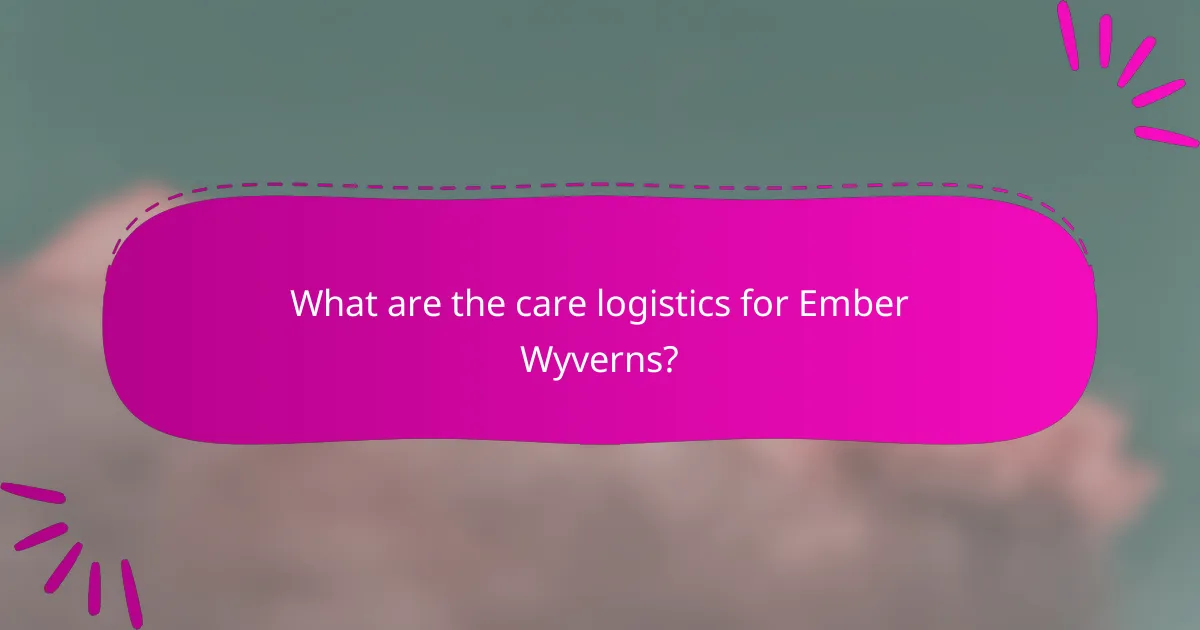
What are the care logistics for Ember Wyverns?
Caring for Ember Wyverns involves specific logistics that ensure their health and well-being. This includes daily routines, seasonal adjustments, and emergency protocols tailored to their unique needs.
Daily care routines
Daily care for Ember Wyverns includes feeding, health checks, and environmental maintenance. They typically require a diet rich in high-protein meats, which can cost around 50-100 USD per week depending on local prices. Regular hydration is essential, so ensure they have access to fresh water daily.
Health checks should focus on their skin and scales, looking for signs of burns or infections. Cleaning their living area is crucial to prevent disease; aim to do this at least once a day.
Seasonal care adjustments
As temperatures change, Ember Wyverns may need adjustments in their care. During colder months, provide additional heating sources to maintain their comfort, as they thrive in warmer conditions. This may involve increasing heating costs by 20-30% in winter.
In warmer seasons, ensure they have shaded areas to prevent overheating. Monitor their hydration levels closely, as they may require more water during hot weather.
Emergency care protocols
In case of emergencies, such as burns or injuries, immediate action is crucial. Keep a first aid kit specifically for Ember Wyverns, including burn ointments and antiseptics. If a serious injury occurs, contact a veterinarian experienced with exotic creatures as soon as possible.
Establish a clear protocol for emergencies, including a list of nearby veterinary clinics and their contact information. Regularly review and practice these protocols to ensure readiness in case of an emergency.
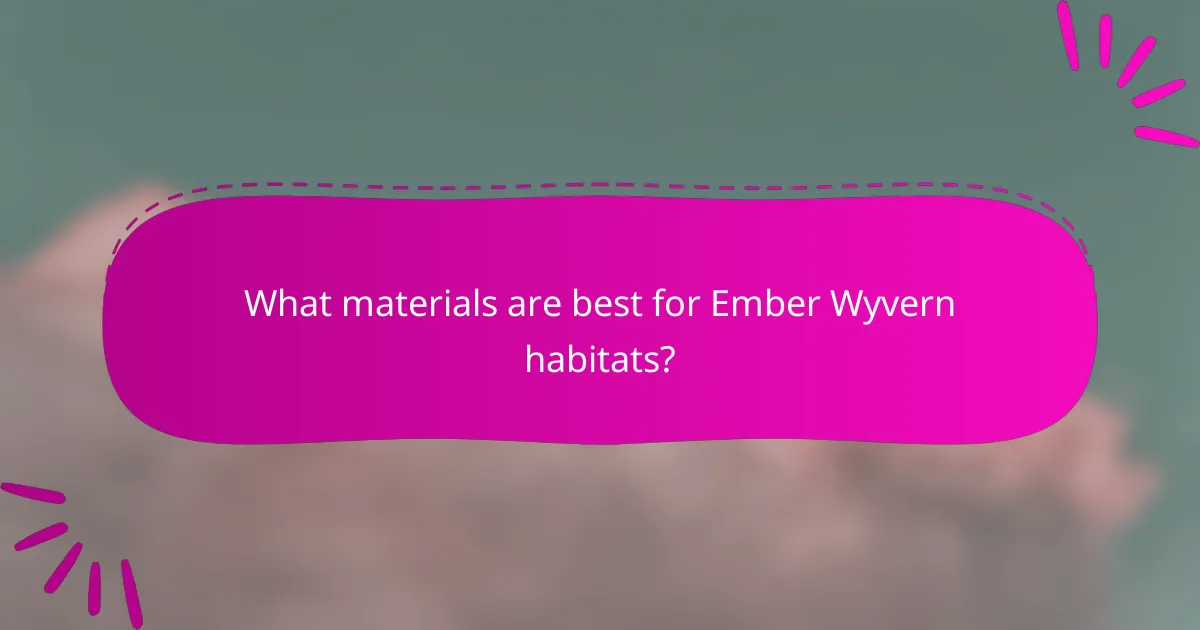
What materials are best for Ember Wyvern habitats?
To create a suitable habitat for Ember Wyverns, you need materials that can withstand high temperatures and provide safety. Fire-resistant insulation, durable flooring, and effective ventilation systems are essential components for maintaining a secure and comfortable environment.
Fire-resistant insulation
Fire-resistant insulation is crucial for Ember Wyvern habitats to prevent heat damage and ensure safety. Materials like mineral wool or fiberglass can effectively resist high temperatures, providing a barrier against heat transfer.
When selecting insulation, consider the R-value, which measures thermal resistance. Aim for insulation with a high R-value to enhance energy efficiency and maintain a stable internal temperature.
Durable flooring options
Choosing the right flooring is vital for Ember Wyvern habitats, as it must withstand wear and resist fire. Options such as concrete, ceramic tiles, or treated metal are ideal due to their durability and fire-resistant properties.
Ensure the flooring is easy to clean and maintain, as Ember Wyverns can produce significant waste. Non-porous surfaces are preferable to prevent bacterial growth and facilitate sanitation.
Ventilation systems
Effective ventilation systems are necessary to maintain air quality and regulate temperature in Ember Wyvern habitats. Installing exhaust fans and intake vents can help manage heat buildup and ensure a steady flow of fresh air.
Consider using temperature and humidity sensors to monitor conditions within the habitat. This data can guide adjustments to the ventilation system, ensuring a comfortable environment for the Ember Wyverns.
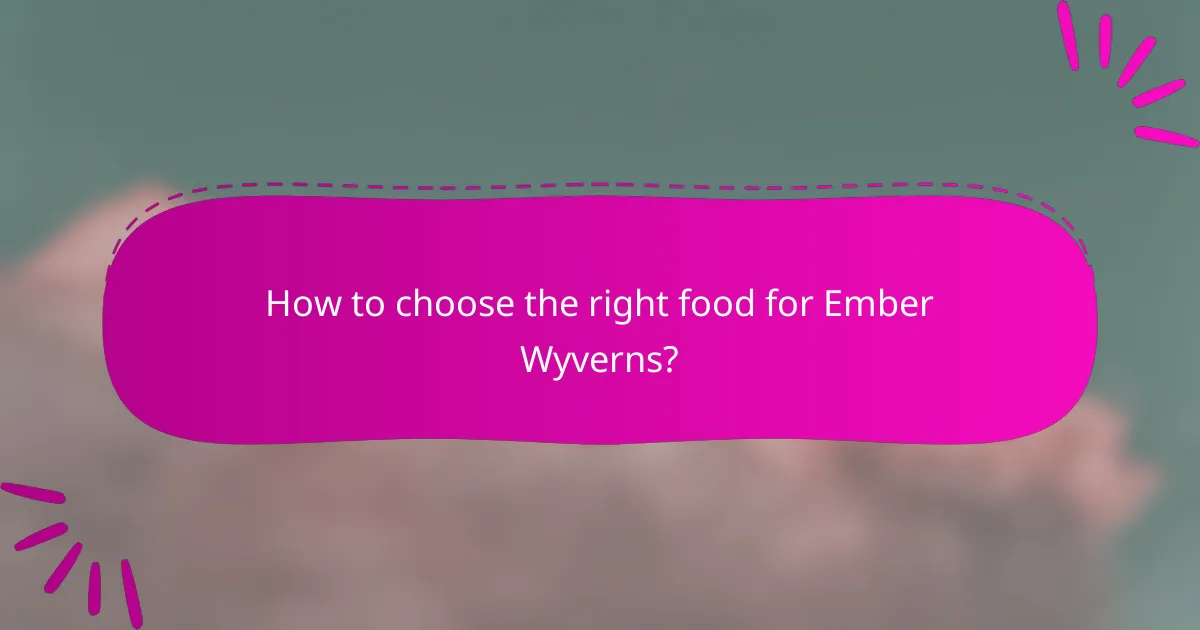
How to choose the right food for Ember Wyverns?
Selecting the right food for Ember Wyverns is crucial for their health and vitality. Focus on their specific nutritional needs, the availability of food sources, and any dietary restrictions they may have to ensure optimal care.
Assess nutritional needs
Ember Wyverns require a balanced diet rich in proteins, fats, and essential vitamins. Their nutritional needs can vary based on age, activity level, and health status, so it’s important to provide a mix of high-quality meats and specialized supplements.
Consider feeding them a diet that consists of approximately 20-30% protein and 10-15% fat. Regularly monitor their weight and overall health to adjust their diet accordingly.
Evaluate food availability
When choosing food for Ember Wyverns, assess the availability of suitable food sources in your area. Fresh meat, fish, and commercially prepared dragon feed can be good options, but ensure they are accessible and affordable.
Establish relationships with local suppliers or farms to secure a consistent food supply. You may also want to consider bulk purchasing to reduce costs and ensure you have enough food on hand.
Consider dietary restrictions
Some Ember Wyverns may have specific dietary restrictions due to allergies or health conditions. Be observant of any adverse reactions to certain foods and adjust their diet as necessary.
Consult with a veterinarian who specializes in exotic creatures to create a tailored feeding plan that considers any restrictions. Avoid common allergens like certain grains or artificial additives to maintain their health.

What are common health issues for Ember Wyverns?
Ember Wyverns can experience several health issues, particularly related to their unique physiology. Common problems include respiratory issues and heat stress, both of which require careful monitoring and management to ensure the well-being of these creatures.
Respiratory problems
Respiratory problems in Ember Wyverns often arise from exposure to smoke or pollutants in their environment. These issues can manifest as coughing, wheezing, or labored breathing, which may indicate underlying infections or irritations.
To prevent respiratory problems, maintain a clean habitat and ensure proper ventilation. Regularly check for signs of respiratory distress and consult a veterinarian if symptoms persist. Avoid exposing them to smoke from fires or other sources, as their lungs are sensitive to irritants.
Heat stress symptoms
Heat stress is a significant concern for Ember Wyverns, especially in warmer climates. Symptoms may include excessive panting, lethargy, and a decreased appetite, signaling that the creature is struggling to regulate its body temperature.
To mitigate heat stress, provide ample shade and fresh water, and monitor their activity levels during peak heat hours. If you notice signs of heat stress, move the wyvern to a cooler environment and offer hydration immediately. Be cautious of overexertion during hot days, as it can exacerbate these symptoms.









